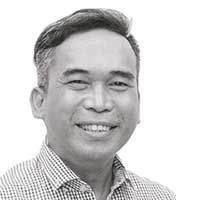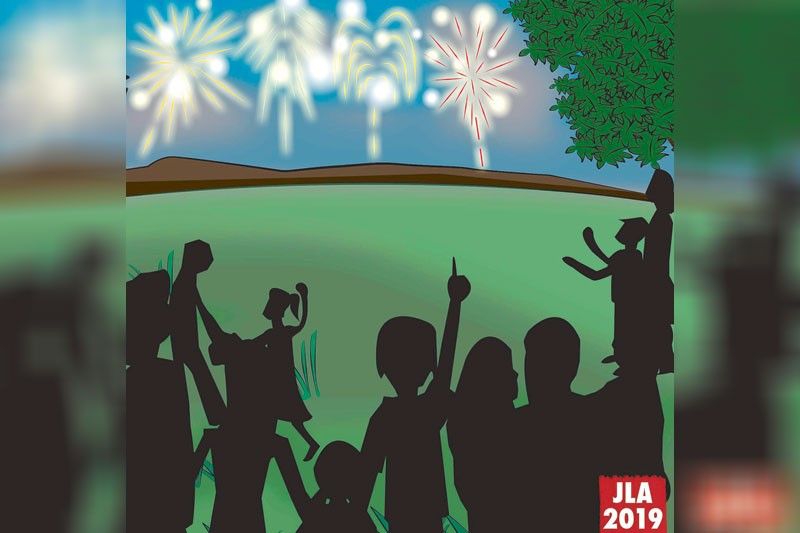The ‘dwendes’ of New Year’s Eve


Long before I found out they were fireworks, I thought of them first as dwendes (elves). Looking back, these dwendes helped me have an imagination so pregnant they gave birth to a thousand and one imaginings. To this day, I remember vividly the dwendes of my childhood.
I was five years old when I first met the dwendes on New Year’s Eve, courtesy of Kuya Syd Hatuina, my cousin in his twenties. Kuya Syd’s flamboyant tone was the voice we followed at 11 p.m. of Dec. 31. He would herd his siblings and cousins — men and women, boys and girls — in the neighborhood for the yearly communion with the dwendes in the middle of the rice field.
In those days, though there was already electricity in the barrio, many houses were still using kerosene lamps. The pathway to the rice field was dark and only the illumination of the moon would guide us on our way. We navigated through thickets of buli palms, makahiya, amor seco (a kind of weed whose flowers stick to the clothes) and uray (a species of thorny weed). Kuya Syd had one cardinal rule: to be silent and still once we reached the field.
A little before midnight, the moon would be covered by the clouds and darkness would engulf the sleepy barrio of Gulod. Kuya Syd hushed the little ones, including me, my cousins Sofia and Norman, not to be afraid.
The elves, he said, didn’t want to be disturbed on New Year’s Eve and any slight movement or noise from us would drive them away. So, there we were, standing in the field or seated on the paddy, in our silence, waiting for the elves to show up. Then suddenly, a bolang apoy (ball of fire) rose and danced in mid-air before it silently exploded into little fairy-like lights. Kuya Syd said the bolang apoy was the elf leader — and our young innocent minds believed him. I got a pinching in my butt for not being able to control my delight and excitement. I kept quiet. But inside me was a revelry. In front of me were dwarves dancing in mid-air.
Many elves were far away — as far as Tagaytay because in front of us was the ridge, though at night it couldn’t be seen. But some were near — or I was just imagining. So near I thought the colorful dwendes in blue, green, red, orange, pink and violet lights were sprouting on top of the rice stalks just a few meters away from us. At one point, my cousins of the same age and I chased the elves but they were gone long before we could catch them.
The more we kept silent and still, the more we saw the dwendes. Many times, as one colorful light popped up after the other, I made a wish and dreamed a dream.
The joyful experience only lasted for a minute or two. But in my mind, it was a lifetime of joy. I grew up knowing I could see elves, albeit in lighted form, on New Year’s Eve.
We would go home exchanging stories about our experiences watching the dances of the dwarves. I would tell my parents and elder brothers about them. They would just scratch their heads as we feasted on ginatang bilo-bilo.
That night I would sleep still dreaming of the dwendes of New Year’s Eve.
* * *
I eventually woke up to the realization that it was fireworks that we saw when I was a child. The realization made me all the more resolute in my belief that the dwendes will grant my wish — a better life, a better future.
In those days, no one could afford to have fireworks in our barrio. Great thanks to Kuya Syd and his imaginative mind who thought of bringing the neighborhood to the field to watch fireworks, err, dwendes. (He said the concept of “dwendes” he also learned from our elder relatives. His being a teacher prompted him to modify the experience.)
And what an experience it was for a kid like me then. The total darkness in the field was the perfect backdrop for a fireworks show from far away. The vast curtain of darkness was the perfect stage where many of my imaginations were shaped and lighted.
But the slowly inching “modernity” in the barrio drove away the dwendes from us. Soon, Sinturon ni Hudas, pantoche, watusi, Super Lolo, among other firecrackers were introduced. They were far more explosive than the kalpot (dud sound) of makeshift kanyon (bamboo canon) that my father made for my brothers.
When almost every household could afford to light Roman candles and “fountains” to welcome the New Year, the dwendes in the rice field were no longer the spectacle. Still, my hands would hold on to pot covers that I used as cymbals to welcome the New Year.
In time, no more kids went to the rice field to see the dwendes of New Year’s Eve. The field that was the stage of our silent and still spirits is now a cemetery. The distant view is now obstructed by some housing developments.
But the dwendes remain in my heart.
I see them still every time I try to write poetry in my mind. I see them still every time I remember my childhood in Gulod.
Life was hard when I was a child but the dwendes somehow carried the weight and made my childhood happy and light.
(For your new beginnings, e-mail me at bumbaki@yahoo.com. I’m also on Twitter @bum_tenorio and Instagram @bumtenorio. Have a blessed Sunday!)














